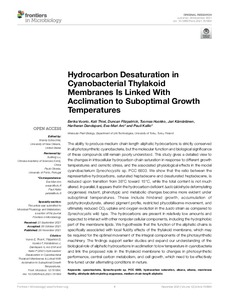Hydrocarbon Desaturation in Cyanobacterial Thylakoid Membranes Is Linked With Acclimation to Suboptimal Growth Temperatures
Vuorio Eerika; Thiel Kati; Fitzpatrick Duncan; Huokko Tuomas; Kämäräinen Jari; Dandapani Hariharan; Aro Eva-Mari; Kallio Pauli
Hydrocarbon Desaturation in Cyanobacterial Thylakoid Membranes Is Linked With Acclimation to Suboptimal Growth Temperatures
Vuorio Eerika
Thiel Kati
Fitzpatrick Duncan
Huokko Tuomas
Kämäräinen Jari
Dandapani Hariharan
Aro Eva-Mari
Kallio Pauli
Frontiers Research Foundation
Julkaisun pysyvä osoite on:
https://urn.fi/URN:NBN:fi-fe2022012711084
https://urn.fi/URN:NBN:fi-fe2022012711084
Tiivistelmä
The ability to produce medium chain length aliphatic hydrocarbons is strictly conserved in all photosynthetic cyanobacteria, but the molecular function and biological significance of these compounds still remain poorly understood. This study gives a detailed view to the changes in intracellular hydrocarbon chain saturation in response to different growth temperatures and osmotic stress, and the associated physiological effects in the model cyanobacterium Synechocystis sp. PCC 6803. We show that the ratio between the representative hydrocarbons, saturated heptadecane and desaturated heptadecene, is reduced upon transition from 38°C toward 15°C, while the total content is not much altered. In parallel, it appears that in the hydrocarbon-deficient ∆ado (aldehyde deformylating oxygenase) mutant, phenotypic and metabolic changes become more evident under suboptimal temperatures. These include hindered growth, accumulation of polyhydroxybutyrate, altered pigment profile, restricted phycobilisome movement, and ultimately reduced CO2 uptake and oxygen evolution in the ∆ado strain as compared to Synechocystis wild type. The hydrocarbons are present in relatively low amounts and expected to interact with other nonpolar cellular components, including the hydrophobic part of the membrane lipids. We hypothesize that the function of the aliphatic chains is specifically associated with local fluidity effects of the thylakoid membrane, which may be required for the optimal movement of the integral components of the photosynthetic machinery. The findings support earlier studies and expand our understanding of the biological role of aliphatic hydrocarbons in acclimation to low temperature in cyanobacteria and link the proposed role in the thylakoid membrane to changes in photosynthetic performance, central carbon metabolism, and cell growth, which need to be effectively fine-tuned under alternating conditions in nature.
Kokoelmat
- Rinnakkaistallenteet [27094]
